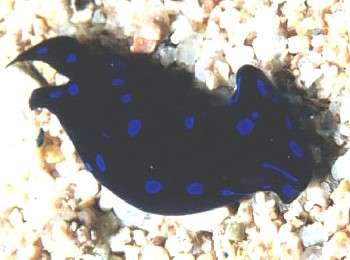
Chelidonura livida
Yonow, 1994
Order: CEPHALASPIDEA
Superfamily: PHILINOIDEA
Family: Aglajidae
DISTRIBUTION
Previously known only from Red Sea but there are records on the Forum from Madagascar. There is also a message [ #3610] reporting a find from the Arafura Sea, northern Australia, suggesting a widespread Indian Ocean distribution
PHOTO
Red Sea, Sharm El Sheikh, divesite "Sharm El Sheikh" Size 15 mm, depth 8 m, nightdive, Sept. 09, 1997. PHOTO: Erwin Koehler
Black, or dark brown, with bright blue spots. It is apparently not uncommon at times on shallow sand flats, and grows to 40mm long. There is a photo in Yonow (1990), as C. africana.
References:
•Yonow, N. (1990) Red Sea Opisthobranchia 3: The orders sacoglossa, Cephalaspidea, and Nudibranchia: Doridacea (Mollusca, Opisthobranchia). Fauna of Saudi Arabia, 11: 286-299.
•Yonow, N. (1994) A new species and a new record of Chelidonura from the Red Sea (Cephalaspidea: Aglajidae). Journal of Conchology, 35: 141-147.
Rudman, W.B., 1999 (September 4) Chelidonura livida Yonow, 1994. [In] Sea Slug Forum. Australian Museum, Sydney. Available from http://www.seaslugforum.net/find/chellivi
Related messages
Chelidonura livida from Mayotte, Indian Ocean
January 16, 2009
From: Sylvain Le Bris
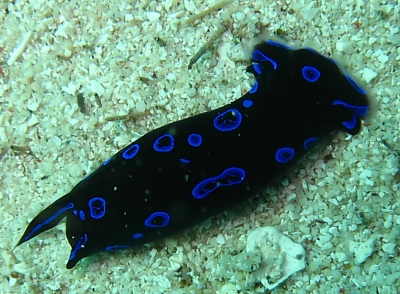
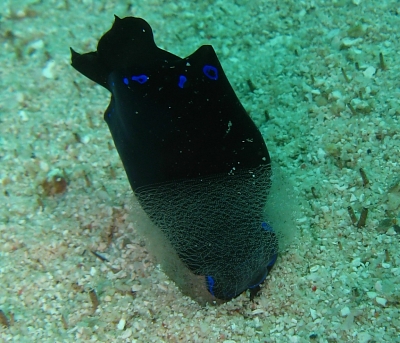
Dear Bill,
Please confirm that this is Chelidonura livida.
This will be the first record from this location in your Forum.
Locality: Nurserie, 8 m, Mayotte, Indian Ocean, 04 December 2008. Length: 2 cm. Photographer: Sylvain Le Bris.
Best regards
Sylvain Le Bris
lebris.sylvain@gmail.com
Le Bris, S., 2009 (Jan 16) Chelidonura livida from Mayotte, Indian Ocean. [Message in] Sea Slug Forum. Australian Museum, Sydney. Available from http://www.seaslugforum.net/find/22110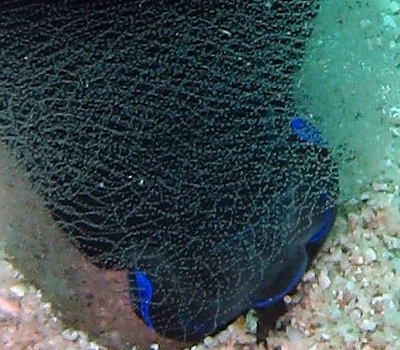
Dear Sylvain,
Yes this is C. livida. Athough politically distinct from Madagascar I would say that in terms of geography and biogeography, Mayotte is very close. Interestingly, the only other records we have on the Forum of animals with fairly distinct blue rings like your animals are in two messages from Madagascar [#3574, #11749]. In the northern part of this species' range the pattern consists of blue spots. At present we don't have a large sample of observations but from those we have, it looks a though there may be a geographic cline in colour pattern from spots to rings from north to south in the Indian Ocean, but as the only other records we have are from the Red Sea and the Persian Gulf we still have a vast area in between to fill in.
Your second photo showing an animal egg laying is interesting. I have included a close-up alongside where you can see the spiralling coils of the egg string being arranged before the 'head' is withdrawn and the eggs sealed in a spherical bubble
Best wishes,
Bill Rudman
Chelidonura livida mating
December 3, 2007
From: Michael Henke
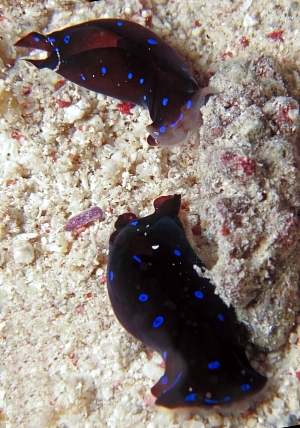
Small Chelidonura livida mating. Hope you like it.
Locality: Mangrove Bay, Sharm el Sheikh, 6 m, Egypt, Red Sea, 13. November 2007, Sand and night. Length: 22 mm. Photographer: Michael Henke.
Regards
Michael
henke@seddoc.de
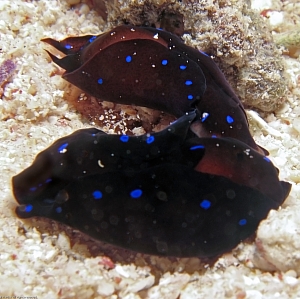
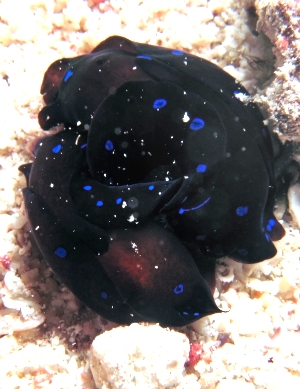
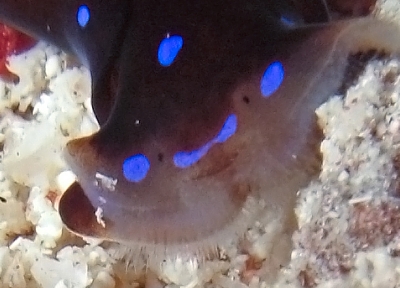
Dear Michael,
Thanks for the photos. Its hard to see details when two black animals are together, but in the middle right photo you can that the animal on the right has the right side of its head - where the penis is situated - nestled in the gap between the parapodia and the mantle cavity of the left animal. This is the position of the female genital opening so I agree that your animals are almost certainly mating.
I have also included a close-up alongside of the head of one of your animals as it shows the small black eyes very clearly and the bushy sensory bristles on two mounds - one on each side of the mouth. These sensory bristles are used to 'smell' or otherwise detect potential prey, and mating partners, by sensing molecules in the mucous trails it finds.
Best wishes,
Bill Rudman
Chelidonura livida from Bahrain
December 17, 2005
From: Mike Arora
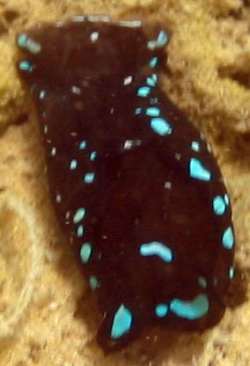
Hi again
This is another sea slug that I have come across in Bahrain, Persian Gulf. Its a pretty awful picture but hopefully you will be able to tell me what it is.
Locality: Bahrain, Persian Gulf. subtidal sand. Depth: 5 m. Length: 2 cm. June 2005. sandy/silty. Photographer: Mike Arora
Thanks again.
Mike
michael@phegulf.com.bh
Arora, M.K, 2005 (Dec 17) Chelidonura livida from Bahrain. [Message in] Sea Slug Forum. Australian Museum, Sydney. Available from http://www.seaslugforum.net/find/15482Dear Mike,
The only aglajid we know of at present with this colour pattern is Chelidonura livida. I am pretty sure that is what your animal is but the posterior end of your animals appears to have two rounded lobes rather than the two tapering pointed 'tails' normally found in species of Chelidonura. It's possible they are contracted in your animal so unless you have clearer photos I'll stick with C. livida at this stage.
Best wishes,
Bill Rudman
Re: Damaged Chelidonura livida from the Red Sea
November 9, 2005
From: John Weinberg
Hi Bill and Oren,
I know this thread [message #13251] is now quite old but I have only just caught up and wanted to add that I have seen seemingly healthly specimens out in the daytime on a number (10+) occasions in the Egyptian Red Sea. They have been relatively shallow, 6m or less, on fine mud/sand near coral reefs although these sightings may have more to do with dive site selection than the distribution of Chelidonura livida.
regards
John Weinberg
john@e-scuba.co.uk
Weinberg, J., 2005 (Nov 9) Re: Damaged Chelidonura livida from the Red Sea. [Message in] Sea Slug Forum. Australian Museum, Sydney. Available from http://www.seaslugforum.net/find/15207Dear John,
There is no dead line on joining conversations. We certainly have much to learn about these animals. Certainly in general terms, species of Chelidonura are less likely to be found burrowing than other members of the family. Many are often seen crawling over coral colonies in the day time, or over coral sand - also in the day time.
Best wishes,
Bill Rudman
Chelidonura livida from Egyptian Red Sea
September 2, 2005
From: Kamal El Tawil
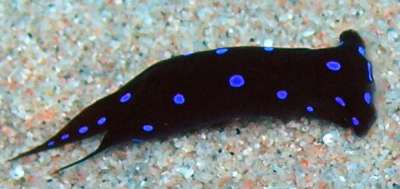
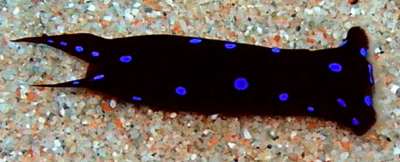
Dear bill:
I fiund this Red Sea Chelidonura on a sand bottom between patches of corals. Its about 1 cm long. Is Chelidonura livida endemic to the Red Sea as my references indicate ?
Locality: Ras Ghozlani, Mersa Breika, Egypt. Red Sea. Depth: 3-4 metres. Length: 10 mm. 21 july 2005. Photographer: Kamal el Tawil
best regards
Kamal
kt@tedata.net.eg
El Tawil, K., 2005 (Sep 2) Chelidonura livida from Egyptian Red Sea. [Message in] Sea Slug Forum. Australian Museum, Sydney. Available from http://www.seaslugforum.net/find/14697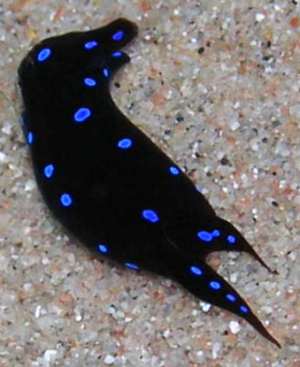
Dear Kamal,
Thanks for these photos. We still have al ot to learn about this species which was only described 10 years ago. Certainly most of the records on the Forum are from the Red Sea, but we have two records with photos from Madagascar and a message from Richard Willan [message #3610] reporting a find from the Arafura Sea, northern Australia, suggesting a widespread Indian Ocean distribution. It always pays to look at relevant Forum messages, we are accumulating a lot of valuable information here which is not available in printed books.
Best wishes,
Bill Rudman
Chelidonura livida - feeding observation
March 4, 2005
From: Iain Macdonald
To add the the dietary information on Chelidonura livida. I have seen, (May 2004), this species "hoovering" up small (4-8 mm) white/opaque flatworms on a sandy bottom (Old Club Reef, Mesaaid, Qatar), Next time I will collect a sample and send them off for identification. The quantity of flatworms indicated that they may have recently been born and C. livida was opportunistically feeding on a locally abundant available food source. Does it feed on flatworms year round is an interesting question.
Locality: Old Club Reef, Qatar, Indian Ocean. Depth: 12 m. May 2004
Artificial reef on sandy bottom.
Iain Macdonald
dr_iamacdonald@yahoo.co.uk
Macdonald, I.A., 2005 (Mar 4) Chelidonura livida - feeding observation. [Message in] Sea Slug Forum. Australian Museum, Sydney. Available from http://www.seaslugforum.net/find/13267Dear Iain,
Thanks for this record
Best wishes,
Bill Rudman
Re: Damaged Chelidonura livida from the Red Sea
March 2, 2005
From: Oren Lederman
Hi Bill,
I'm not so sure about the regrowth. The nudibranch wasn't moving at all, and was spotted during a day dive (according to my experience they can only be found during night dives).
Oren Lederman
lederman@bigmail.co.il
Lederman, O., 2005 (Mar 2) Re: Damaged Chelidonura livida from the Red Sea. [Message in] Sea Slug Forum. Australian Museum, Sydney. Available from http://www.seaslugforum.net/find/13251Thanks Oren,
I suspected regrowth because the bits didn't seem to fit together properly but from your comments its just a very sick? dead? animal
Best wishes,
Bill Rudman
Damaged Chelidonura livida from the Red Sea
March 1, 2005
From: Oren Lederman
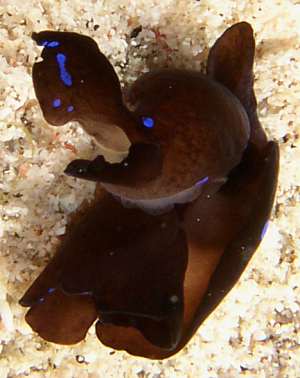
Hi Bill,
We believe this one is Chelidonura livida. It appears that something took a bite on this one..
Locality: "The reservation", Eilat Bay, Israel, Red Sea. Depth: Approx 6 meters. Length: ~3 cm. 17 Feb 2005. Photographer: Oren Lederman
Oren Lederman
lederman@bigmail.co.il
Lederman, O., 2005 (Mar 1) Damaged Chelidonura livida from the Red Sea. [Message in] Sea Slug Forum. Australian Museum, Sydney. Available from http://www.seaslugforum.net/find/13205Dear Oren,
Yes this is a damaged C. livida. It seems there has been some regrowth after the 'accident' as there seems to be some extra bits and pieces. The crescent of white fuzzy stuff you can see halfway along the body is part of the gills which are usually hidden under the very distorted posteriopr flaps of tissue which normally for a posterior facing funnel.
Best wishes,
Bill Rudman
Chelidonura livida from the Red Sea
March 1, 2005
From: Oren Lederman
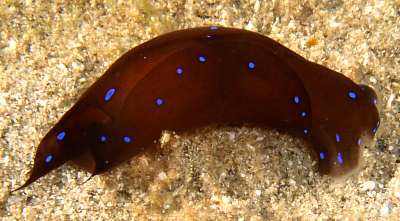
Hi Bill,
To accompany the damaged Chelidonura livida [message #13205] here is a photo of what I think is a color variation of Chelidonura livida.
Locality: North Beach, Eilat Bay, Israel, Red Sea. Depth: ~4 meters. Length: 3-4 cm.16 Feb 2005. Photographer: Oren Lederman
Oren Lederman
lederman@bigmail.co.il
Lederman, O., 2005 (Mar 1) Chelidonura livida from the Red Sea. [Message in] Sea Slug Forum. Australian Museum, Sydney. Available from http://www.seaslugforum.net/find/13206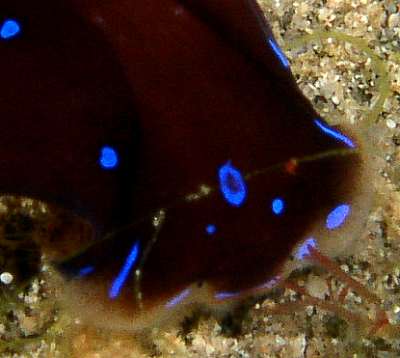
Dear Oren,
Thanks for these photos of what, until very recently, has been an unknown species. I have included a close-up alongside to show some features of its head. Although difficult to see, species of Chelidonura has groups of sensory bristles along the front edge of the head which they use to 'smell' their prey, almost certainly by sensing chemicals in the mucus trail of their prey. Until recently we had no idea what Chelidonura ate, but we now know that at least some species feed on small flatworms. If you get the opportunity to see any species of Chelidonura feeding, or get the chance to put a small flatworm in front of a Chelidonura and watch what happens, it would be a valuable bit of information.
On each side of the central black bump on the front of the head is a small black spot. These are its eyes. However they can't form images, and as far as we know all they can possibly do is sense light and dark, so may be useful in letting the slug know when it is in a dark place [safe from predators] or for sensing a shadow [perhaps a predator] passing over it? One other possible use is to help 'set the time' on its biological clocks. We know in some land snails that the eyes have associated cells producing hormones involved in daily and more long-term rhythms so its possible that the same mechanisms apply in slugs.. Certainly aglajids and other bubble-shells I have kept in aquaria had well developed daily rhythms, burrowing into the sand and emerging from the sand with remarkable regularity each day.
Best wishes,
Bill Rudman
Chelidonura livida in Madagascar
January 5, 2004
From: Valérie Grando
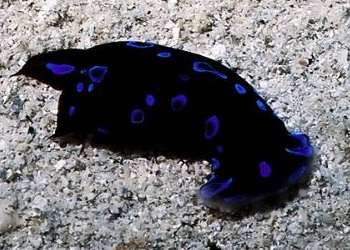
Hi
I found this Chelidonura livida in November 2003 around Nosi Be in Madagascar
Valérie
vgrando@nordnet.Fr
Grando, V., 2004 (Jan 5) Chelidonura livida in Madagascar. [Message in] Sea Slug Forum. Australian Museum, Sydney. Available from http://www.seaslugforum.net/find/11749Thanks Valérie,
It's nice to get another record from Madagascar. Leif's earlier message rom Madagascar, and Richard Willan's message from Nthn Australia are the only previous reports of this species outside the northern Indian Ocean
Best wishes
Bill Rudman
Chelidonura livida - request for information
November 23, 2002
From: Nils Anthes
Dear "Red Sea enthusiasts",
During a Uni field course at Sharm el Sheikh in May 2003 I intend to do some observations on mating behaviour and mating conflicts in Chelidonura livida, which is mainly known from the Red Sea. I would appreciate if some divers who have seen the species around Sharm could come up with some more details on
- specific location
- date
- number of individuals
- witnessed matings? What could you see?
- substrate
- depth
- time of the day
- all other information that might be of interest.
The species is of particular interest to me, as the "gamete trading hypothesis", which aims to explain alternating reciprocal sperm exchange in hermaphrodites, has been developed (by Janet Leonard) using a related species, Navanax inermis, as a model system.
• Leonard, J.L. & Lukowiak, K .(1984) An ethogram of the sea slug, Navanax inermis (Gastropoda, Opisthobranchia). Z. Tierpsychol, 65: 327-345.
• Leonard, J.L. & Lukowiak, K. (1985) Courtship, copulation, and sperm trading in the sea slug, Navanax inermis (Opisthobranchia: Cephalaspidea). Can. J. Zool., 63: 2719-2729.
Thanks for any responses!
Nils
anthes@uni-muenster.de
Dear Nils,
I guess you've seen the other messages on the Forum, including Erwin Koehler's from Sharm el Sheikh. The aglajids you are likely to find are quite a bit smaller than Navanax but some of the little sand dwellers, such as Chelidonura sandrana can occur in very large numbers even on intertidal sand flats covered by only a few centimeters of water. It appears that C. livida is also a sand dwelling species. From my experience, its always a bit dangerous to base your research plan on one particular species. Opisthobranchs are not very reliable - even the most common species will not be there the week you need it. However if you base your plan on any species of aglajid you could be lucky. It may not be C. lividus by I assume any species will do the job.
Best wishes,
Bill Rudman
Mating Chelidonura livida from Egypt
September 25, 2002
From: Michael Mrutzek
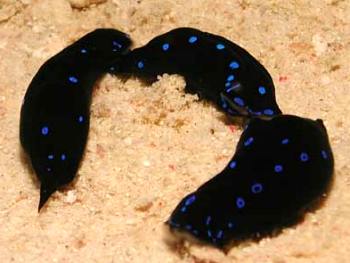
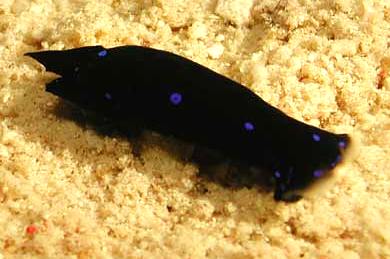
Dear Bill,
I am sending you some photos of slugs from the Red Sea for use in the Forum. They were taken on the reefs off Hurghada, on the Red Sea coast of Egypt, August, 2002. These two [Photo Copyright: Michael Mrutzek] were from Erg Estha, at dawn, 6 Meters.
Michael Mrutzek
Mrutzek@meeresaquaristik.de
Mrutzek, M., 2002 (Sep 25) Mating Chelidonura livida from Egypt. [Message in] Sea Slug Forum. Australian Museum, Sydney. Available from http://www.seaslugforum.net/find/8036Dear Michael,
Thanks for these photos. They are of Chelidonura livida, a carnivorous 'bubble-shell' which probably feeds on small flatworms. Your upper photo showing the three animals together is of particular interest as it shows a 'mating chain' of 3 animals. I have discussed how mating chains develop in dense populations of Sea Hares. Aglajids, such as Chelidonura do the same.
Thanks for the photos of other species which I will post over the next few days.
Best wishes,
Bill Rudman
Chelidonura livida from Red Sea
April 16, 2002
From: Marina Poddubetskaia
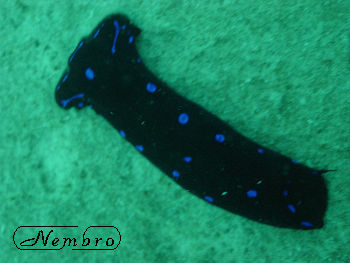
Dear Bill,
At the end of March I spent a week in Egypt. It was a dive cruise at the North of Red Sea, between Hurghada and Sinai mountains. All the joined photos come from there.
Could you confirm this is Chelidonura livida please?
Data: about 5 cm, 19 March 2002, unknown site, North Red Sea, 5-7m depth
I saw this cephalaspidean only at this site. There was nothing but the sand, everywhere, and a lot of these guys : some dozens at least in a small area. Thank you for your help.
Best wishes,
Marina
marina.poddubetskaia@francetelecom.com
Poddubetskaia, Marina. , 2002 (Apr 16) Chelidonura livida from Red Sea. [Message in] Sea Slug Forum. Australian Museum, Sydney. Available from http://www.seaslugforum.net/find/6720Dear Marina,
Yes this is C. livida.
Best wishes,
Bill Rudman
Chelidonura livida from United Arab Emirates
May 15, 2001
From: Peter Hardy
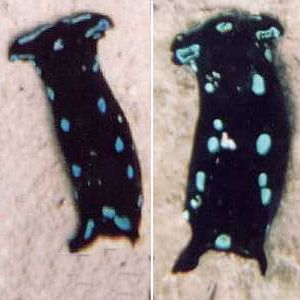
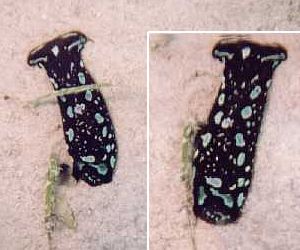
I have, I believe, noted a group of Chelidonura livida in the shallow waters of The Club in Abu Dhabi, United Arab Emirates. They are in 0.5 to 2.0 meters of water in a busy swimming area of this recreational club, in April 2001.
Although I have used this area often for both swimming and also as a scuba training site I have not seen, or heard of, them before. They were all seen just on the fringe of the areas of weed just below the low water level.
Best wishes,
Pete
hardy@emirates.net.ae
Hardy, P., 2001 (May 15) Chelidonura livida from United Arab Emirates. [Message in] Sea Slug Forum. Australian Museum, Sydney. Available from http://www.seaslugforum.net/find/4261Dear Pete,
Thanks for this interesting selection of photos which show it variability in colour. It's definitely an animal we don't know much about but seems to be quite common in the Red Sea, NW Indian Ocean region.
Bill Rudman
Geographic range of Chelidonura livida
January 23, 2001
From: Richard Willan
Bill,
Your mention recently of "large extension of geographic range" in connection with Chelidonura livida, prompted me to tell you that the range of this species is actually much more extensive than the western Indian Ocean and Red Sea. I have a specimen that was taken in 17 metres, north of Port Essington, Cobourg Peninsula, Arafura Sea, northern Australia, in August 1986. It was taken in a trawl for prawns, and was just about to be swept back over the side with the rest of the "trash" when I pounced on it. Perhaps this species favours muddy substrates, rather than coral reefs as do other species Chelidonura, which explains why it is so little known?
Cheers,
Richard
Richard.Willan@nt.gov.au
Willan, R.C., 2001 (Jan 23) Geographic range of Chelidonura livida. [Message in] Sea Slug Forum. Australian Museum, Sydney. Available from http://www.seaslugforum.net/find/3610Thanks Richard.
Just to set the record straight I didn't actually say "large extension of geographic range" I said "large extension of its known geographic distribution". I think its important to get the message across that we know very little about most opisthobranchs and sightings such as Leif's and yours can make a major difference, changing our view of the species from that of a Red Sea endemic to a species which is widespread, at least in the Indian Ocean. One aim of the Forum is provide a place for all of us to share these little bits of information, which otherwise would effectively remain "unknown" to the scientific community.
I guess its a bit early to say whether it favours muddy substrates. Let's see if someone can find they have a photo of it from the Pacific.
Best wishes,
Bill Rudman
Chelidonura livida from Madagascar
January 21, 2001
From: Leif Abrell
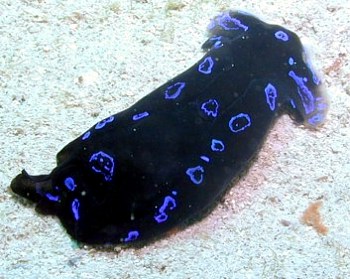
Dear Bill,
Here is another of the opisthobranchs I photographed in NW Madagascar in April, 2000. It is Chelidonura livida.
Photos of the other opisthobranchs can be seen at http://www.columbia.edu/~la202/Mad-opisth2000.html
Leif
lagartica@hotmail.com
Abrell, L., 2001 (Jan 21) Chelidonura livida from Madagascar. [Message in] Sea Slug Forum. Australian Museum, Sydney. Available from http://www.seaslugforum.net/find/3574Dear Leif,
Thanks for the photo of an interesting colour variation and a large extension of its known geographic distribution.
Bill Rudman
Chelidonura livida
October 13, 1999
From: Erwin Koehler

Bill,
here is another photo of Chelidonura livida. Same dates as the other one, but the blue spots are better visible.
Locality: Red Sea, Sharm El Sheikh, divesite "Sharm El Sheikh" Size 15 mm, depth 8m, nightdive, Sept. 09, 1997.
Erwin
Medslugs.Koehler@t-online.de
Koehler, E., 1999 (Oct 13) Chelidonura livida. [Message in] Sea Slug Forum. Australian Museum, Sydney. Available from http://www.seaslugforum.net/find/1419Thanks Erwin,
It is a spectacular little animal, but like all the 'black' species, very difficult to photograph.
Best wishes,
Bill Rudman.
Chelidonura livida from Red Sea
September 7, 1999
From: Erwin Koehler
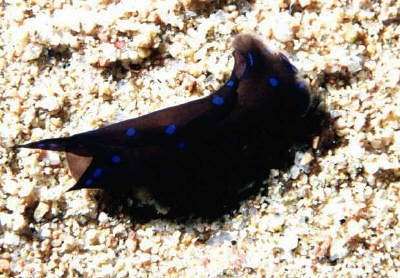
Bill,
Here is Chelidonura livida Yonow, 1994.
Locality: Red Sea, Sharm El Sheikh, divesite "Sharm El Sheikh" Size 15 mm, depth 8m, nightdive, Sept. 09, 1997.
Erwin
Medslugs.Koehler@t-online.de
Koehler. E., 1999 (Sep 7) Chelidonura livida from Red Sea. [Message in] Sea Slug Forum. Australian Museum, Sydney. Available from http://www.seaslugforum.net/find/1296Dear Erwin,
This is one species of Chelidonura I have not seen alive. It is certainly has a spectacular colour pattern.
Bill Rudman.
